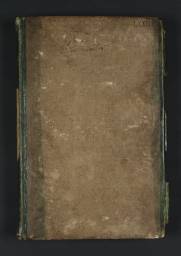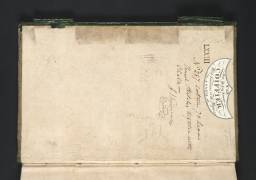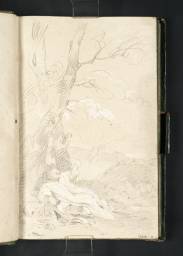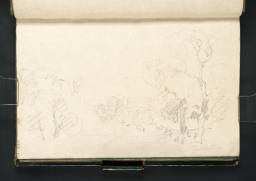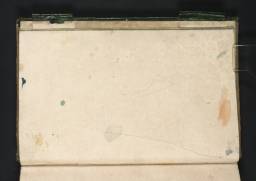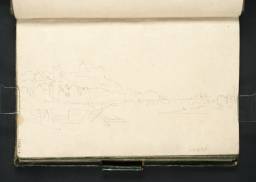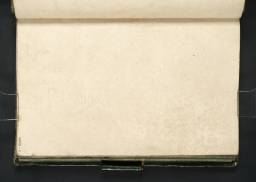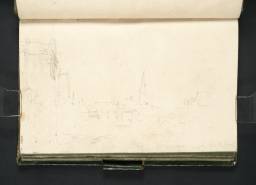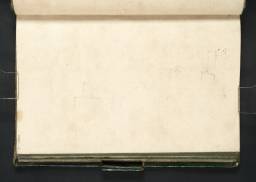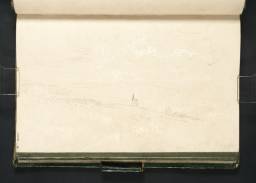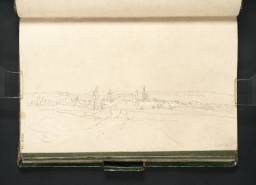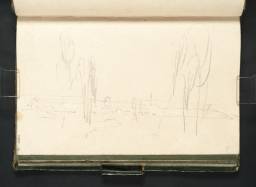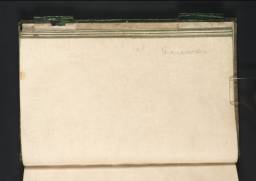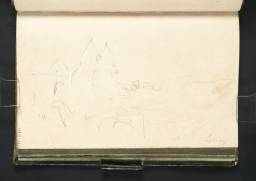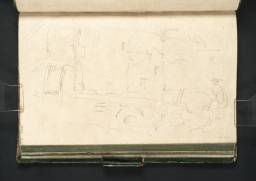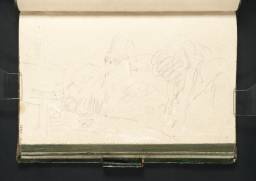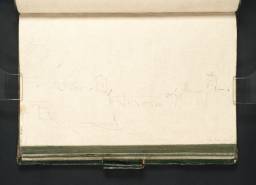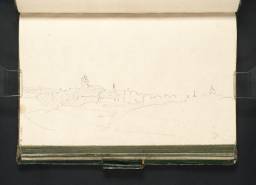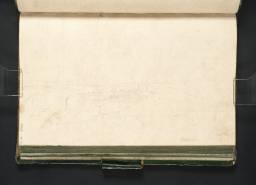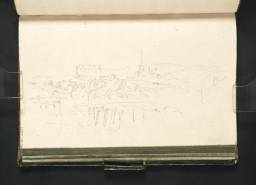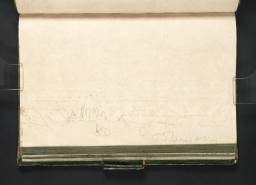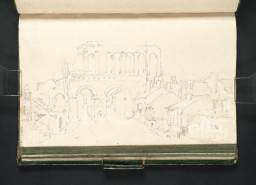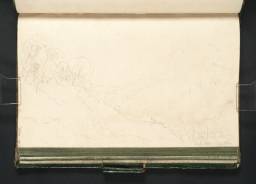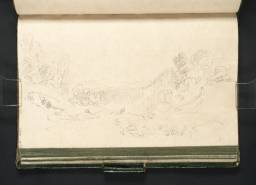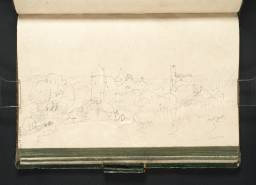Turner Bequest LXXIII
Sketchbook bound in boards, paper covered, with dark green leather borders and spine, the edges of the leaves washed in green
78 leaves of light grey-buff laid paper
Approximate page size 215 x 138 mm
Made by Jean-Louis Delagarde at Papeteries du Marais, Seine et Marne, France; various pages watermarked ‘[...]erene & Raff[...] du Marais’. Supplied by Coiffier, Paris (label inside front cover, D04391)
Inscribed by Turner in ink ‘93 France Swiss’ on a label on the spine and ‘France | Savoy | Piedmont’ on the cover (D40785)
Numbered 287 as part of the Turner Schedule in 1854 and endorsed by the Executors of the Turner Bequest, inside front cover (D04391)
78 leaves of light grey-buff laid paper
Approximate page size 215 x 138 mm
Made by Jean-Louis Delagarde at Papeteries du Marais, Seine et Marne, France; various pages watermarked ‘[...]erene & Raff[...] du Marais’. Supplied by Coiffier, Paris (label inside front cover, D04391)
Inscribed by Turner in ink ‘93 France Swiss’ on a label on the spine and ‘France | Savoy | Piedmont’ on the cover (D40785)
Numbered 287 as part of the Turner Schedule in 1854 and endorsed by the Executors of the Turner Bequest, inside front cover (D04391)
Exhibition history
References
This sketchbook was used during Turner’s first continental tour in 1802 (see Introduction, Sketchbooks from the Tour to Switzerland 1802). He bought it in Paris, at the shop whose label appears inside the cover, and used it between Paris and Lyon, around Grenoble, in Geneva, in the Chamonix valley, around Mont Blanc and at Courmayeur in the Val d’Aosta. The date span of the contents thus runs from about 19 July, Turner having probably arrived in Paris the previous evening, to mid August. It is the only sketchbook used during the 1802 tour to remain intact.
The subjects of most of the drawings are identified, albeit sometimes approximately and occasionally wrongly, in Turner’s inscriptions. In clarifying or correcting these, David Hill’s published research and private comments to the compiler have been invaluable.1 The title of the sketchbook is also Turner’s own, reflecting his sense (anachronistic or perhaps optimistic) of the territories through which he passed. The old Alpine kingdoms of Savoy and Piedmont, which had formed part of the kingdom of Sardinia, had been occupied by French forces in 1792 and turned into a French-run ‘Department’, while in 1798 Napoleon divided north Italy into three client Republics and combined the Cantons of Switzerland into a single Helvetic Republic. The French were ejected from north Italy in 1799 but regained it at Marengo a year later. The Amiens treaty of 28 March 1802 had required their withdrawal from Italy and from the Helvetic Republic, though Turner would have found plenty of evidence that this had not in fact taken place.
The sequence of drawings in this sketchbook is at times haphazard, not always following Turner’s route. One drawing, of a picture by Pier Francesco Mola in the Louvre (folio 2, D04394), was probably made on first passing through Paris – in which case it would mark Turner’s first use of the book – rather than during his longer stay in the city on the way back. The lighter paper proved more amenable to pencil sketches jotted down while travelling than the prepared, washed leaves of the sketchbooks Turner had brought from London. The sketches are mostly slight and sometimes rudimentary in the extreme, reflecting haste as much as Turner’s opinion of the scenery. His comment to Joseph Farington, ‘The Country to Lyons very bad’,2 can hardly have applied to all he saw thus far – to the environs of Paris, perhaps, or to the bleak and rocky wilderness of the Morvan, but certainly not to the richer landscapes of Burgundy since a view of Tournus and the Saône valley (folio 19, D04411) was one of the several sketches in the book that Turner put to use for paintings and watercolours. Turner’s repeated use of the later pages for drawings of the spectacular mountain scenery around Courmayeur – for which he might have been expected to prefer his larger St Gothard and Mont Blanc sketchbook (Tate D04590–D04648; D41390–D41391; Turner Bequest LXXV) – is perhaps surprising, unless, as Hill has suggested, he had not been prepared for its splendours and had left himself insufficient time to work on a larger scale.3 The majority of the drawings are of landscape format, and some are double-page spreads.
Turner referred to this book for several subsequent works. Folio 19 together with related drawings in the Calais Pier sketchbook (Tate D05018, D05019; Turner Be quest LXXXI 116, 117) contributed to the background of The Festival upon the Opening of the Vintage of Macon (Sheffield Galleries & Museums Trust)4 exhibited at the Royal Academy in 1803. Views of mountains on folio 46 verso (D04441) were developed in a colour study (Tate D04901; Turner Bequest LXXX H) and then in Châteaux de St Michael, Bonneville, Savoy (Yale Center for British Art, New Haven, Connecticut)5 also for the Academy in 1803. Another of Le Chetif on folio 62 verso (D04460) served as the basis of a watercolour exhibited the same year, St Huges Denouncing Vengeance on the Shepherd of Cormayer, in the Valley of d’Aoust (Sir John Soane’s Museum, London).6 Views of Lake Geneva on folios 5 and 35 (D04397, D04427) were consulted for a watercolour made about 1808 for Walter Fawkes (Yale Center for British Art, New Haven, Connecticut),7 and have colour trials made as he worked on it.
Recorded by Farington in his diary entry for 1 October 1802; see Kenneth Garlick and Angus Macintyre eds., The Diary of Joseph Farington, vol.V, New Haven and London 1979, p.1890.
Technical notes
How to cite
David Blayney Brown, ‘France, Savoy, Piedmont sketchbook 1802’, sketchbook, October 2009, in David Blayney Brown (ed.), J.M.W. Turner: Sketchbooks, Drawings and Watercolours, Tate Research Publication, December 2012, https://www

